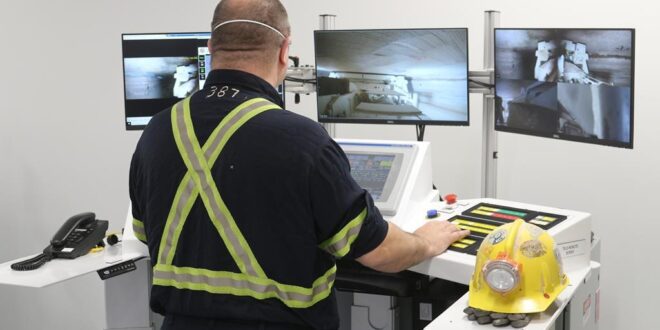The Future of Mining: Automation Takes Center Stage
CALGARY — The global mining industry is experiencing a significant shift towards automation and remote technology, eliminating the need for human labor in some of the most hazardous operations. Gone are the days when coal miners relied on canaries to detect toxic gases. Today, companies are implementing advanced technologies such as driverless haul trucks, remote-controlled drilling machines, and artificial intelligence-powered systems to enhance safety and productivity.
Nutrien Ltd., based in Saskatoon, has successfully developed tele-remote technology at its potash mines in Saskatchewan. Last fall, the company achieved a major milestone by mining an entire production wing at its underground Lanigan site without any human presence on site. Using a combination of cutting-edge technologies including radar, cameras, advanced sensing systems, and artificial intelligence, Nutrien operated a massive potash boring machine from a control room a few hundred meters away from the mining face. This accomplishment marks a significant step towards making potash mining safer by removing workers from hazardous underground locations.
Improving Safety in the Mining Industry
Mining has always been fraught with risks, particularly in underground operations where cave-ins, fires, floods, and poisonous air pose grave dangers. However, even open-pit mines pose potential hazards such as collisions and equipment rollovers. In Canada alone, the mining, quarrying, and oil and gas extraction industries reported 51 workplace fatalities in 2021. Such safety concerns have driven the ongoing transition towards automation in the industry.
Across the globe, mining companies are adopting automation technologies to improve safety. The Boddington gold mine in Western Australia has replaced human drivers with a fully autonomous haulage fleet. BHP, a mining giant in Chile, is installing autonomous drills at its Spence copper mine. Chinese telecom firm Huawei has introduced 5G technology to facilitate the operation of underground mines remotely. In Canada, Teck Resources Ltd. is already utilizing an autonomous haulage system at its Elkview steel-making coal mine in British Columbia.
Benefits of Automation in Mining
Automation offers numerous advantages to mining companies, including increased productivity and enhanced safety. Tele-remote operated mining machines, for example, do not require breaks or shift changes, leading to higher productivity. Imperial Oil, the operator of the Kearl oilsands mine in northern Alberta, reported a 10 to 15 percent boost in productivity with its fleet of autonomously operated heavy-haul trucks compared to staffed trucks. Autonomous vehicles also have the advantage of faster maneuverability and tighter spacing, resulting in quicker loading and improved efficiency.
Redefining Job Roles in Mining
The rapid pace of automation is reshaping the job landscape in mining. Some mining companies now value software skills more than truck-driving abilities. Language in collective agreements between mining companies and unions highlights the employees’ concerns regarding job security in the face of remote-operated equipment and driverless trucks. However, Nutrien claims that its tele-remote mining program has not resulted in any job losses. Instead, it has shifted equipment operators from hazardous physical locations to safe control rooms. Other mining companies, like Imperial, have redeployed former truck drivers to other parts of the organization or retrained them to operate different equipment.
A More Accessible and Inclusive Mining Industry
The implementation of remote and autonomous technology has the potential to make the mining industry more inclusive and attractive to a broader range of individuals. Safety is greatly improved when workers can operate in controlled environments, away from the noise, dust, heat, and vibration of mining sites. This shift can appeal to women, older workers, and individuals with physical disabilities, broadening the diversity within the mining industry.
The Future of Mining: Going Underground Will No Longer Be Necessary
Industry experts predict a future where mining can be conducted without the need for anyone to go underground. While automation and remote technology in mining have only gained significant momentum recently, technological capabilities already exist. In a world where flip phones have been swiftly replaced by smartphones, the advancement of mining technology is not far off. The mining industry is set to undergo a transformation that maximizes safety and productivity through automation.
This report by The Canadian Press was first published on June 25, 2023.
Companies in this story: (TSX:NTR; TSX:IMO; TSX:SU)
Amanda Stephenson, The Canadian Press
 Mind Uncharted Explore. Discover. Learn.
Mind Uncharted Explore. Discover. Learn.



